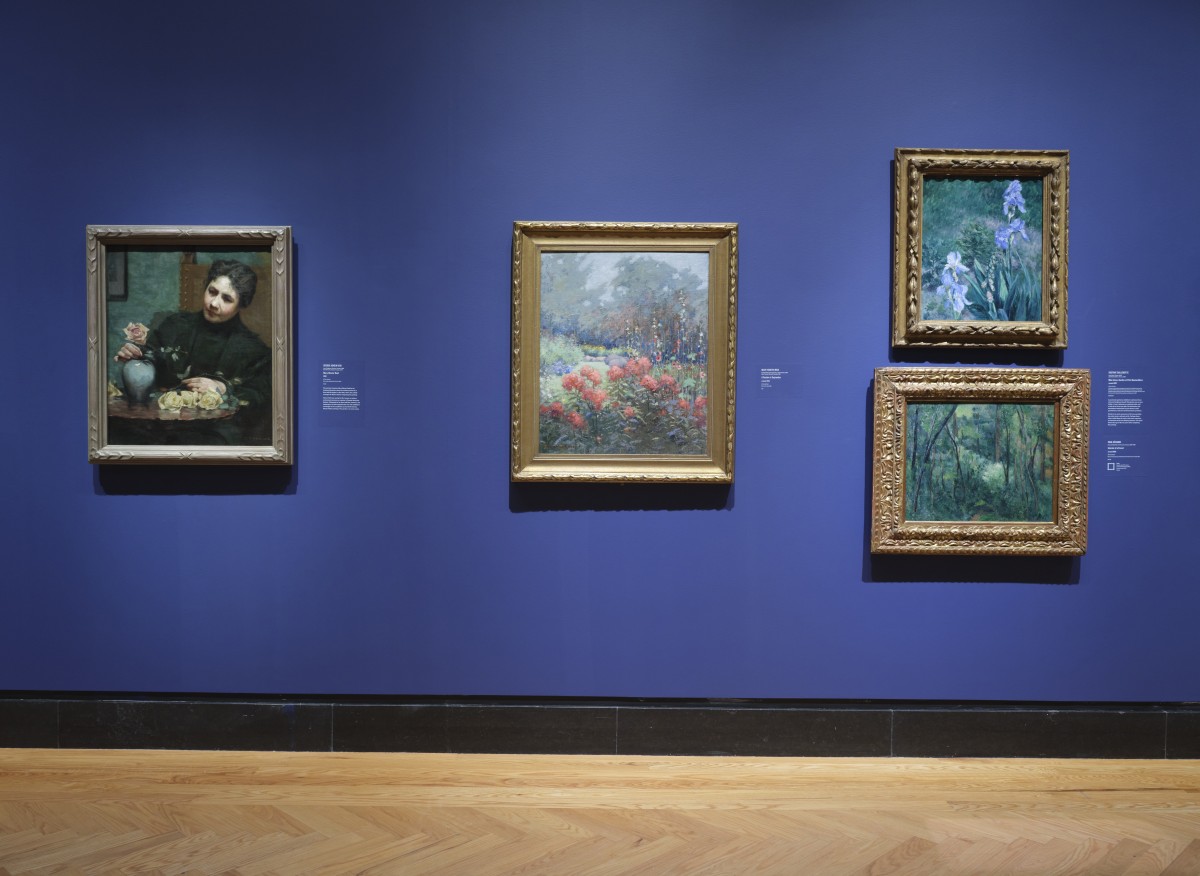Gardens of delight
In the AGO European Galleries, a quartet of paintings reveals a shared passion, oceans apart.

Installation view, (Left) George Agnew Reid. Portrait of Mary Hiester Reid, 1898; (middle) Mary Hiester Reid, A garden in September. C. 1894; (Lower right) Paul Cezanne. Interior of a forest, c.1885; (Upper right) Gustave Caillebotte, Iris bleus, jardin du Petit Gennevilliers, c. 1892. All images © AGO.
On the western wall of the Richard Barry Fudger Memorial Gallery, gallery 125 on Level 1, an unlikely quartet of paintings has been installed. On the left, we see a woman arranging flowers. In the middle, we see a well-ordered autumnal garden. To the right lies a manicured blue iris perched atop a shimmering green forest. Between them, an ocean of blue paint, as deep and as real as the Atlantic.
Like a foursome at bridge, these late 19th century works speak across the table to each other. And the language? That of flowers. That the two on the left were made in Toronto and the two on right in France reflects the bigger, more global artistic conversation about nature and painting happening between the years 1880 and 1900.
“We are increasingly coming to understand Impressionism as a global movement. By including Canadian artists in this gallery normally dedicated to European art, we can see Impressionism isn’t something Canadian artists merely read about, but something they engaged in, studied and made their own,” says Caroline Shields, AGO Associate Curator and Head of European art. “Canadian artists travelled to Europe, studied and worked there, and participated in rich dialogues with European artists. Impressionism radiated across the globe, inspiring artists in many different ways and I hope this installation allows visitors to see that for themselves.”
Characterized by their refined elegance, Mary Hiester Reid’s poetic and exquisite compositions blend nature with domestic life to suggest poetic harmony, even as she defied convention and gender bias to become a successful professional artist on her own terms. The artistic power couple of their day, Mary and her husband, the painter George Agnew Reid, settled in Toronto in 1885, where she steadily gained critical acclaim for her painted floral still life, interiors and landscapes. Although very much rooted in Toronto, they remained closely allied to trends in European art. George Agnew Reid had studied under Benjamin Constant in Paris, and their time spent painting and studying in Paris deeply influenced them both. On the far left we see Agnew Reid’s portrait of Mary, and in her hand, cut flowers. Adjacent to it, A garden in September, an oil on canvas Hiester Reid made of her well-ordered Toronto garden located in Wychwood Park, in 1894.
Across the sea, in France, the independently wealthy artist and patron Gustave Caillebotte was a leader of the Impressionist movement. He was also a dedicated gardener and a pioneer of garden genre scenes. Renowned for his friendships with fellow botanical enthusiasts like Claude Monet, his own style, became looser and more vivid as he aged, seen here in Blue Irises, Garden at Petit Gennevilliers (1892). Painted just two years before the end of his life (Caillebotte passed away unexpectedly at age 46) and two years before Hiester Reid’s A garden in September, Blue Irises offers us a glimpse into the gardens he and his contemporaries loved so dearly.
Shields says it is the 19th century French poet Octave Mirbeau, who in a letter to Monet, perhaps best summarizes the unity of gardening and painting: “...I am very happy that you are bringing Caillebotte. We will talk about gardening, as you say, because as for art and literature, that’s all just banter. There is nothing but earth…”
Hanging below Caillebotte’s painted flowers is a small forest scene by Paul Cézanne. Pre-dating both the Caillebotte and Hiester Reid, his Interior of a forest is an effective foil, no less alluring for its lack of cultivation.
“Garden scenes, when first planted and nurtured and then painted by artists, re-double the creative act in a wholly unique way,” continues Shields. “Caillebotte and Hiester Reid are not only the creators of the painting but they actually gave life to these flowers. They brought the flowers into being and they share that bond. The Cézanne, by contrast, is about perception and the artist’s role in interpreting, as opposed to creating, the world around us.”
Did you know? AGO Members and Annual Passholders need only scan their digital cards at the door to see these and other works in the AGO Collection. No advance booking required.
